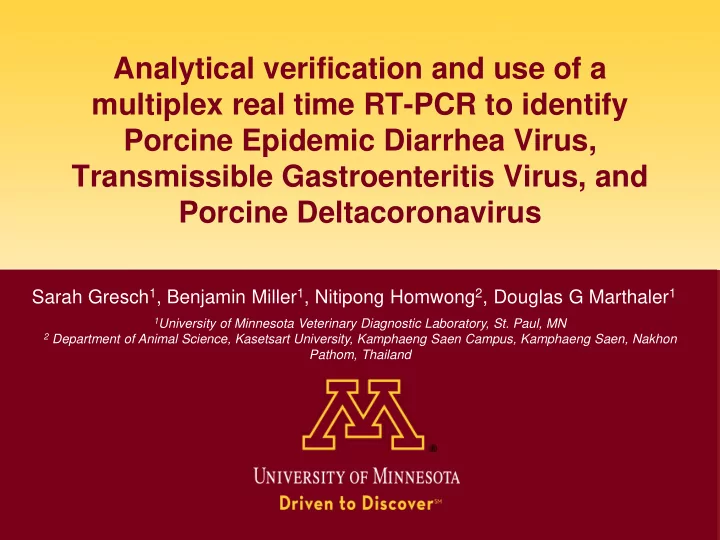

Analytical verification and use of a multiplex real time RT-PCR to identify Porcine Epidemic Diarrhea Virus, Transmissible Gastroenteritis Virus, and Porcine Deltacoronavirus Sarah Gresch 1 , Benjamin Miller 1 , Nitipong Homwong 2 , Douglas G Marthaler 1 1 University of Minnesota Veterinary Diagnostic Laboratory, St. Paul, MN 2 Department of Animal Science, Kasetsart University, Kamphaeng Saen Campus, Kamphaeng Saen, Nakhon Pathom, Thailand
Porcine Enteric Coronaviruses • Cause significant economic losses for swine farmers • US Swine industry provides $20 billion in annual gross income • 3 porcine enteric CoVs are present in North America
Disease Significance and Impact Swine Enteric Coronavirus Diseases – Porcine Epidemic Diarrhea Virus (PEDV) • Severe diarrhea, vomiting and dehydration (SECD) – Porcine Deltacoronavirus (PDCoV) • Diarrhea – Transmissible Gastroenteritis Virus (TGEV) • Severe diarrhea, vomiting and dehydration Lost about 3.7 million pigs in the US during the “year of PEDV ”
High Volume Testing – Environmental testing to monitor and control the spread of disease within and between farms – Clinical symptoms are similar among PEDV / PDCoV / TGEV (PDT) • Requires laboratory confirmation
Why a multiplex PCR? – UMN Vet Diagnostic Lab TGEV 2014-2016 averaged: PEDV/ 54,500 PEDV rRT-PCRs per year PDCoV – Multiplexing saves reagents, supplies, equipment time/usage and technician PDT time Triplex
Partnership and Reagents – QIAGEN virotype PEDV/ TGEV/ PDCoV RT-PCR Reagents • PDT primers/probes (2 µL/rxn) • Positive PCR control - Virotype mix 1 + IC (18 µL/rxn) AAVLD strongly suggests the use of an internal control in all new PCR tests
PDT Assay Parameters Target Reporter PEDV FAM PDCoV Cy5 TGEV JOE Internal Control TAMRA Passive reference ROX Temperature Time # Cycles Fast! 50 o C 1 10 min 95 o C 1 About 45 2 min 95 o C 5 sec minutes 40 60 o C 30 sec
Limit of Detection U of MN QIAGEN Ct Value vs. TCID50 Found the PCR is Ct value sensitive to 1-10 viral copies per reaction for each pathogen Log10 (TCID50)
Amplification Efficiency • The amount of PCR product increase after each cycle 𝐹 𝑄𝐹𝐸𝑊 = −1 + 10 −1 𝑡𝑚𝑝𝑞𝑓 = −1 + 10 −1 −3.5107 = −1 + 10 0.2848 = 0.9965 = −1 + 10 0.2972 = 0.9825 𝐹 𝑄𝐸𝐷𝑝𝑊 = −1 + 10 −1 𝑡𝑚𝑝𝑞𝑓 = −1 + 10 −1 −3.3646 = −1 + 10 0.3014 = 1.0017 𝐹 𝑈𝐻𝐹𝑊 = −1 + 10 −1 𝑡𝑚𝑝𝑞𝑓 = −1 + 10 −1 −3.318 Ct Value vs. TCID50 - PEDV: 99.7% Ct value - PDCoV: 98.3% - TGEV: 100% Log10 (TCID50)
Repeatability Excellent repeatability: <4% in all cases U of MN QIAGEN Interassay Intra-assay Inter-assay Limit Of Detection Series n=3 <4% Sample 1 n=6 <1% n=6 <1% Internal Control n=360 1.7% Sample 2 n=6 <1% n=6 <1% PDCoV Pos Control n=298 1.2% Sample 3 n=6 <1% n=6 <1% PEDV Pos Control n=298 1.1% Sample 4 n=6 <1% n=6 <1% TGEV Pos Control n=298 0.9% Pos control n=6 <1% n=6 <1%
Analytical Specificity Confirmed no cross-reactivity with 56 bacterial and viral isolates • • • Porcine cytomegalovirus Porcine Adenovirus Clostridium perfringens type C • • • North American Porcine Porcine Circovirus Type I Salmonella typhimurium Reproductive and • • Porcine Circovirus Type II Brachyspira hampsonii Colon A Respiratory Syndrome • • Picorna virus (Seneca Valley Brachyspira hampsonii Colon B • European Porcine Virus) • Brachyspira hyodysenteriae Reproductive and • Porcine Rotavirus Group B • Brachyspira pilosicoli Respiratory Syndrome • Porcine Rotavirus Group C • Brachyspira murdochii • Pseudorabies virus • Porcine Lymphotropic Gamma • Brachyspira intermedia • Swine Influenza virus H1 Herpes Virus 1 • Brachyspira innocens • Swine Influenza virus H2 • Porcine Lymphotropic Gamma • Actinobacillus suis • Swine Influenza virus H3 Herpes Virus 2 • + • Porcine Respiratory Corona • Porcine Hokovirus virus • Beta-hemolytic Escherichia coli
Diagnostic Comparison – 360 samples compared between the UMN in-house assays and Qiagen’s PDT triplex • 127 feces / fecal swabs • 99 intestines • 92 oral fluids • 42 environmental samples
Correlation PDT triplex compared to our previous, in-house PCRs: 98% 98% 100%
Diagnostic Sensitivity and Specificity Diagnostic Sensitivity: Diagnostic Specificity: (The ability to detect true positives) (The ability to detect true negatives) PEDV 87% PEDV 99% PDCoV 92% PDCoV 98% TGEV 100% TGEV 100% True positives True negatives (true positives + false negatives) (true negatives + false positives)
Diagnostic Sensitivity and Specificity Diagnostic Sensitivity: Diagnostic Specificity: (The ability to detect true positives) (The ability to detect true negatives) PEDV 87% PEDV 99% PDCoV 92% PDCoV 98% TGEV 100% TGEV 100% Disagreements between 11 oral fluid samples (positive with old method but negative with PDT triplex)
Study Limitations • Diagnostic sensitivity and specificity calculations assume our previous in- house assays are the “gold standard” • TGEV positive samples rare – all TGEV comparison samples either negative or strongly positive • Oral fluid discrepancies in 11 samples; unknown which assay gave the true result for these
Conclusions • QIAGEN’s PDT triplex is in -use at the U of MN VDL – Faster Time to results <1 hr – Better Meets acceptance criteria – Cheaper Saves money via reduced reagents, technician time and equipment use
Thank you
Recommend
More recommend